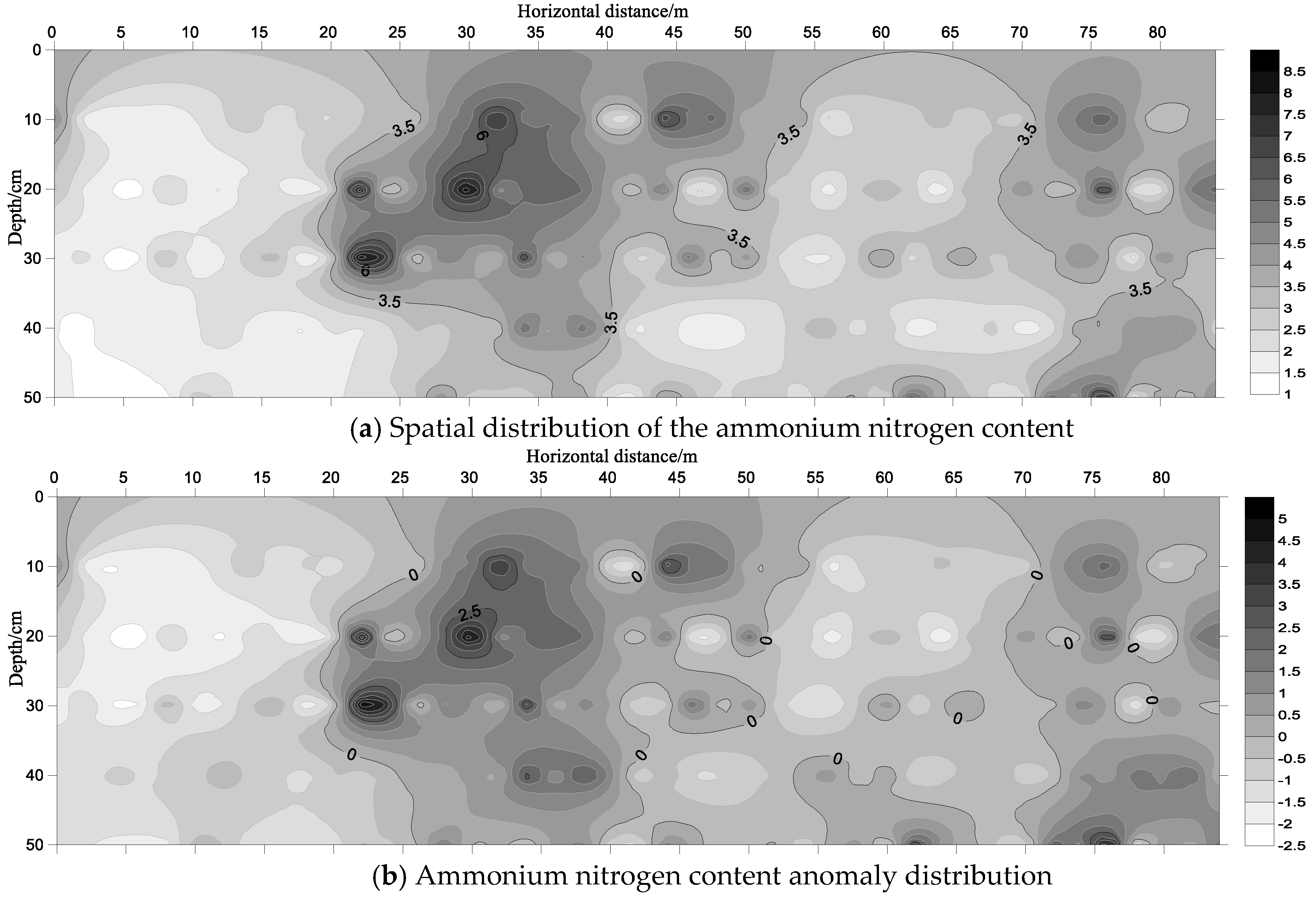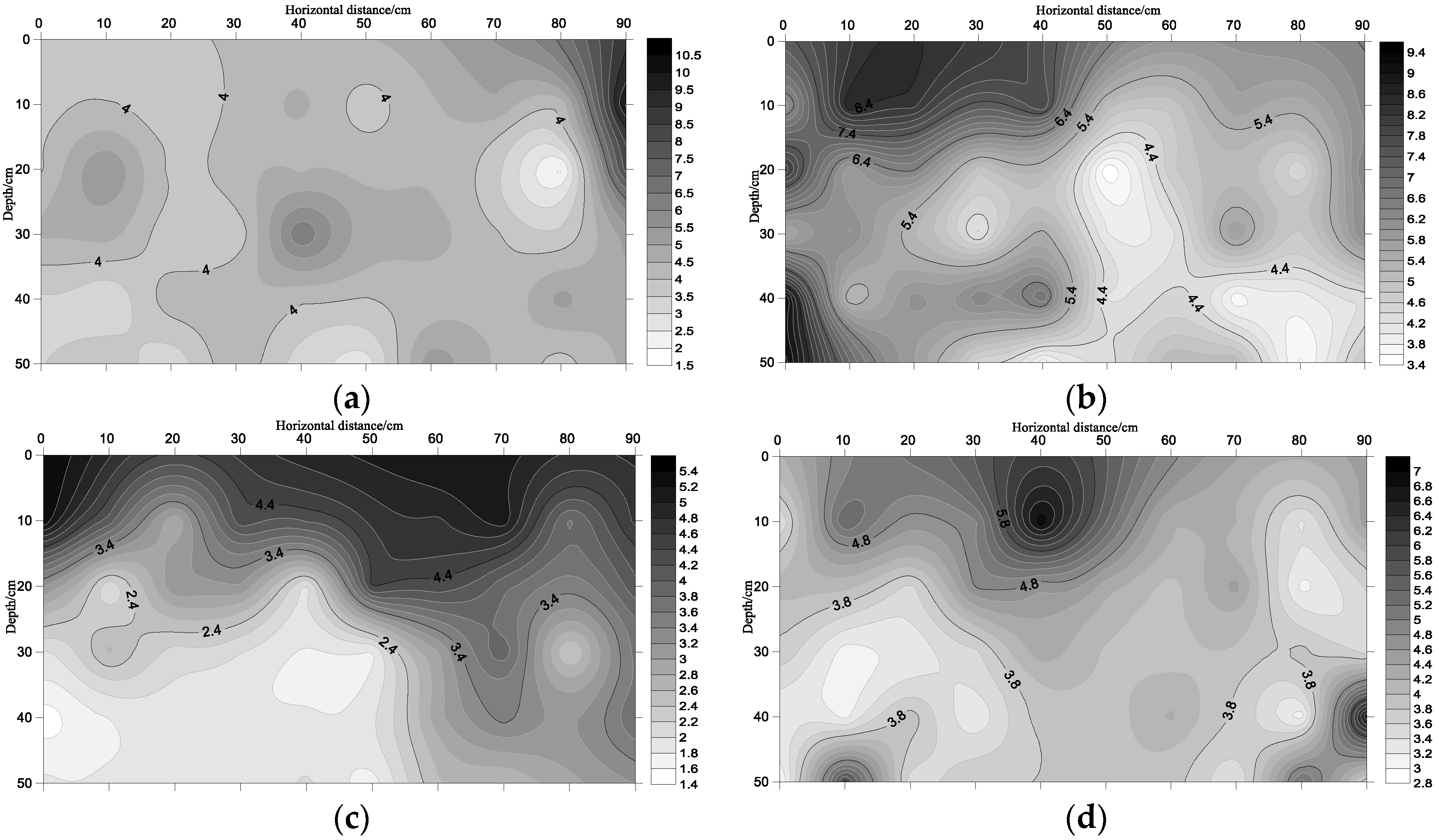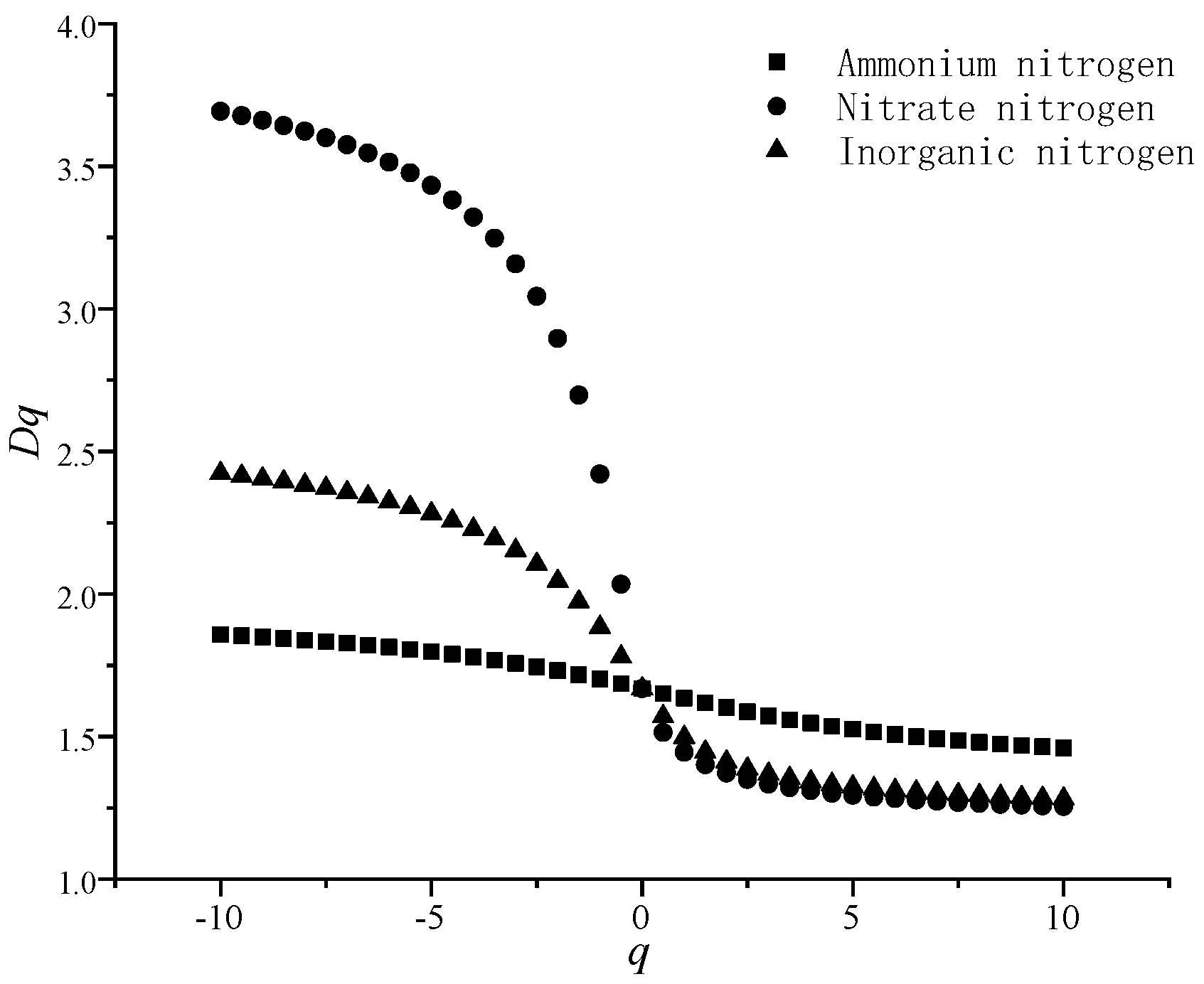Quantifying the Spatial Distribution of Soil Nitrogen under Long-Term Drip Fertigation
Abstract
:1. Introduction
2. Materials and Methods
2.1. Study Area
2.2. Sampling Methods
3. Results and discussion
3.1. Spatial Distribution Characteristics of Nitrate Nitrogen and Ammonium Nitrogen under Drip Fertigation
3.2. Descriptive Statistics of the Spatial Variability of Nitrate Nitrogen and Ammonium Nitrogen under Drip Fertigation
3.3. Multifractal Characteristics of Nitrogen under Drip Fertigation
4. Conclusions
Author Contributions
Funding
Institutional Review Board Statement
Informed Consent Statement
Acknowledgments
Conflicts of Interest
References
- Shen, L.F.; Bai, L.Y.; Zeng, X.B.; Wang, Y.Z. Effects of Fertilization on NO3--N Accumulation in Greenhouse Soils. J. Agro-Environ. Sci. 2012, 7, 1350–1356. [Google Scholar]
- Wang, H.; Xiang, Y.; Zhang, F.; Tang, Z.; Guo, J.; Zhang, X.; Hou, X.; Wang, H.; Cheng, M.; Li, Z. Responses of yield, quality and water-nitrogen use efficiency of greenhouse sweet pepper to different drip fertigation regimes in Northwest China. Agric. Water Manag. 2022, 260, 107279. [Google Scholar] [CrossRef]
- Hu, J.; Gettel, G.; Fan, Z.; Lv, H.; Zhao, Y.; Yu, Y.; Wang, J.; Butterbach-Bahl, K.; Li, G.; Lin, S. Drip fertigation promotes water and nitrogen use efficiency and yield stability through improved root growth for tomatoes in plastic greenhouse production. Agric. Ecosyst. Environ. 2021, 313, 107379. [Google Scholar] [CrossRef]
- Guo, S.R.; Sun, S.; Li, J. General situations, charactics and trends of protected horticulture in foreigns. J. Nanjing Agric. Univ. 2012, 5, 43–52. [Google Scholar]
- Liao, R.K.; Yu, H.L.; Yang, P.L. Multifractal analysis of soil particle size distribution to evaluate the effects of gypsum on the quality of sodic soils. Eur. J. Soil Sci. 2021, 72, 1726–1741. [Google Scholar] [CrossRef]
- Contreras, J.I.; Baezar, R.; Alonso, F.; Cánovas, G.; Gavilán, P.; Lozano, D. Effect of Distribution Uniformity and Fertigation Volume on the Bio-Productivity of the Greenhouse Zucchini Crop. Water 2020, 12, 2183. [Google Scholar] [CrossRef]
- Wang, Y.; Dannenmann, M.; Lin, S.; Lv, H.; Li, G.; Lian, X.; Wang, Z.; Wang, J.; Butterbach-Bahl, K. Improving soil respiration while maintaining soil C stocks in sunken plastic greenhouse vegetable production systems-Advantages of straw application and drip fertigation. Agric. Ecosyst. Environ. 2021, 316, 107464. [Google Scholar] [CrossRef]
- Lv, H.F.; Lin, S.; Wang, Y.F.; Lian, X.; Zhao, Y.; Li, Y.; Du, J.; Wang, Z.; Wang, J.; Butterbach-Bahl, K. Drip fertigation significantly reduces nitrogen leaching in solar greenhouse vegetable production system. Environ. Pollut. 2019, 245, 694–701. [Google Scholar] [CrossRef]
- Cai, Y.H.; Yao, C.P.; Wu, P.T.; Zhang, L.; Zhu, D.; Chen, J.; Du, Y. Effectiveness of a subsurface irrigation system with ceramic emitters under low-pressure conditions. Agric. Water Manag. 2021, 243, 106390. [Google Scholar] [CrossRef]
- Hou, X.H.; Zhu, Y.H.; Li, F.Y.; Xia, Z.Y.; Meng, X.G.; Jia, H.K. Effects of irrigation methods on soil available nu-trient state and its spatial heterogeneity in jujube root zone. China Rural Water Hydropower 2018, 11, 125–135. [Google Scholar]
- Chen, W.L.; Ran, S.H.; Liu, T.T. Distribution characteristics of soil salinity in cotton fields under different irrigation methods-taking the manas river midstream irrigation district as an example. J. Irrig. Drain. 2018, 37, 33–37. [Google Scholar]
- Ma, C.X.; Ding, J.L.; Yang, A.X.; Wang, L.; Niu, Z.Y. Spatial heterogeneity analysis of main parameters of soil sali-nization in Oasis region. J. Arid. Land Resour. Environ. 2015, 29, 144–149. [Google Scholar]
- Gouri, S.B.; Pravat, K.S.; Rabindranath, C. Assessment of spatial variability of soil properties using geostatistical approach of lateritic soil (West Bengal, India). Ann. Agrar. Sci. 2018, 16, 436–443. [Google Scholar]
- Liu, J.L.; Liu, L.; Ma, X.Y.; Fu, Q.; Wang, H.J.; Zhang, Z.H.; Zhang, L.L.; Yu, P. Spatial variability of soil salinity in different soil layers with different scales. J. Basic Sci. Eng. 2018, 26, 305–311. [Google Scholar]
- Liao, R.K.; Zhang, S.R.; Zhang, X.; Wang, M.; Wu, H.; Zhangzhong, L. Development of smart irrigation systems based on real-time soil moisture data in a greenhouse: Proof of concept. Agric. Water Manag. 2021, 245, 106632. [Google Scholar] [CrossRef]
- Guan, X.Y.; Yang, P.L.; Lv, Y. Spatial variability analysis of farmland soil properties based on multifractal theory. J. Sci. Eng. 2001, 19, 712–720. [Google Scholar]
- Liu, J.L.; Ma, X.Y.; Zhang, Z.H. Multifractal study on spatial variability of soil water and salt and its scale effect. Trans. CSAE 2010, 26, 81–86. [Google Scholar]
- Guan, X.Y.; Wang, S.L.; Lv, Y.; Fu, X.J. Multifractal analysis of spatial variability of soil water and salt and its scale effect. J. Hydraul. Eng. 2013, 44, 8–14. [Google Scholar]
- Wang, J.M.; Zhang, J.R.; Yu, F. Characterizing the spatial variability of soil particle size distribution in an under-ground coal mining area: An approach combining multi-fractal theory and geostatistics. Catena 2019, 176, 94–103. [Google Scholar] [CrossRef]
- Guan, X.Y.; Yang, P.L.; Li, L.; Tan, Y.N. Multifractal characteristics of soil pore distribution after long-term recycled water irrigation. J. Drain. Irrig. Mach. Eng. 2018, 36, 1163–1167. [Google Scholar]
- Yao, R.J.; Yang, J.S.; Liu, G.M.; Zou, P. Spatial variability of soil salinity in characteristic field of the Yellow River delta. Trans. Chin. Soc. Agric. Eng. 2006, 22, 61–66. [Google Scholar]
- Caniego, F.; Espejo, R.; Martin, M.A.M.; José, F. Multifractal scaling of soil spatial variability. Ecol. Model. 2005, 182, 291–303. [Google Scholar] [CrossRef]
- Eghball, B.; Schepers, J.S.; Negahban, M.; Schlemmer, M.R. Spatial and temporal variability of soil nitrate and corn yield: Multifractal analysis. Agron. J. 2003, 95, 339–346. [Google Scholar] [CrossRef]
- Zeleke, T.B.; Si, B. Characterizing scale-dependent spatial relationships between soil properties using multifractal techniques. Geoderma 2006, 134, 440–452. [Google Scholar] [CrossRef]
- Li, J.S.; Yang, F.Y.; Li, Y.F. Water and nitrogen distribution under subsurface drip fertigation as affected by lay-ered-textura1 soils. Trans. Chin. Soc. Agric. Eng. 2009, 25, 25–30. [Google Scholar]
- Cote, C.M.; Bristow, K.L.; Charlesworth, P.B.; Cook, F.J.; Thorburn, P.J. Analysis of soil wetting and solute transport in subsurface trickle irrigation. Irrig. Sci. 2003, 22, 143–156. [Google Scholar] [CrossRef]
- Huang, Y.H.; Wang, K.; Yang, J.H. Distribution of soil water and available nitrogen in purple soil under drip fertilization. J. Soil Water Conserv. 2014, 28, 87–95. [Google Scholar]
- Zhang, W.; Lv, Y.J.; Tang, X.Y. Study on water movement and output dynamics of colloidal particles in purple soil slope farmland. J. Irrig. Drain. 2018, 37, 58–63. [Google Scholar]
- Biswas, A.; Cresswell, H.P.; Chau, H.W.; Rossel, R.A.V.; Si, B.C. Separating scale-specific soil spatial variability: A comparison of multi-resolution analysis and empirical mode decomposition. Geoderma 2013, 209–210, 57–64. [Google Scholar] [CrossRef]
- Zeleke, T.B.; Si, B.C. Scaling properties of topographic indices and crop yield: Multifractal and joint multifractal approaches. Agron. J. 2004, 96, 1082–1090. [Google Scholar] [CrossRef]
- Kravchenko, A.N.; Bullock, D.G.; Boast, C.W. Joint Multifractal Analysis of Crop Yield and Terrain Slope. Agron. J. 2000, 92, 1279–1290. [Google Scholar] [CrossRef] [Green Version]








| Depth (cm) | Particle Size Fraction (%) | Soil Bulk Density (g/cm3) | pH | ||
|---|---|---|---|---|---|
| Sand | Silt | Clay | |||
| 0–20 | 28.75 | 65.00 | 6.25 | 1.42 | 8.38 |
| 20–40 | 24.00 | 61.50 | 14.50 | 1.46 | 8.58 |
| 40–60 | 5.75 | 76.50 | 17.75 | 1.62 | 8.72 |
| Depth/(cm) | Mean/(mg/kg) | SD | Max/(mg/kg) | Min/(mg/kg) | CV | |
|---|---|---|---|---|---|---|
| 0–10 | 26.20 | 38.71 | 171.13 | 5.18 | 1.48 | |
| 10–20 | 12.50 | 10.98 | 66.96 | 4.84 | 0.88 | |
| NO3–N | 20–30 | 7.29 | 3.71 | 23.45 | 4.73 | 0.43 |
| 30–40 | 7.77 | 4.96 | 30.01 | 4.73 | 0.64 | |
| 40–50 | 7.05 | 6.06 | 45.00 | 4.75 | 0.85 | |
| 0–10 | 3.59 | 1.53 | 7.53 | 1.48 | 0.43 | |
| 10–20 | 3.57 | 1.93 | 8.79 | 1.12 | 0.54 | |
| NH4–N | 20–30 | 3.32 | 1.59 | 8.50 | 1.22 | 0.48 |
| 30–40 | 2.62 | 1.11 | 5.73 | 1.28 | 0.42 | |
| 40–50 | 2.89 | 1.39 | 7.89 | 1.13 | 0.48 |
| Nitrogen Index. | Depth | D0–D1 | αmin(q) | f(αmin) | αmax(q) | f(αmax) | Δα(q) | Δf(α) |
|---|---|---|---|---|---|---|---|---|
| Ammonium Nitrogen | 0–50 cm | 0.0340 | 1.3841 | 0.7023 | 1.9521 | 0.9150 | 0.5680 | −0.2127 |
| 0–30 cm | 0.0336 | 1.2500 | 0.6395 | 1.8241 | 0.6863 | 0.5741 | −0.0468 | |
| 40–50 cm | 0.0286 | 1.0751 | 0.2331 | 1.6175 | 0.7169 | 0.5424 | −0.4838 | |
| Nitrate Nitrogen | 0–50 cm | 0.1731 | 1.9818 | 1.3768 | 0.9142 | 0.2276 | 1.0676 | −1.1492 |
| 0–30 cm | 0.1735 | 1.8993 | 1.1060 | 0.8412 | 0.2276 | 0.8784 | −0.8784 | |
| 40–50 cm | 0.0488 | 1.5001 | 1.2202 | 0.8336 | 0.0337 | 0.6665 | −1.1865 | |
| Inorganic Nitrogen | 0–50 cm | 0.1615 | 1.9615 | 1.3542 | 0.9213 | 0.2248 | 1.0402 | −1.1294 |
| 0–30 cm | 0.1627 | 1.8739 | 1.0883 | 0.8465 | 0.2248 | 1.0274 | −0.8635 | |
| 40–50 cm | 0.0433 | 1.4878 | 1.2014 | 0.8450 | 0.0358 | 0.6428 | −1.1656 |
Publisher’s Note: MDPI stays neutral with regard to jurisdictional claims in published maps and institutional affiliations. |
© 2022 by the authors. Licensee MDPI, Basel, Switzerland. This article is an open access article distributed under the terms and conditions of the Creative Commons Attribution (CC BY) license (https://creativecommons.org/licenses/by/4.0/).
Share and Cite
Bi, Y.; Wu, W.; Hou, L.; Liao, R.; Bi, X.; Wang, L.; Chen, Y. Quantifying the Spatial Distribution of Soil Nitrogen under Long-Term Drip Fertigation. Water 2022, 14, 1337. https://doi.org/10.3390/w14091337
Bi Y, Wu W, Hou L, Liao R, Bi X, Wang L, Chen Y. Quantifying the Spatial Distribution of Soil Nitrogen under Long-Term Drip Fertigation. Water. 2022; 14(9):1337. https://doi.org/10.3390/w14091337
Chicago/Turabian StyleBi, Yaran, Wenyong Wu, Lizhu Hou, Renkuan Liao, Xiangshuai Bi, Linlin Wang, and Yuehong Chen. 2022. "Quantifying the Spatial Distribution of Soil Nitrogen under Long-Term Drip Fertigation" Water 14, no. 9: 1337. https://doi.org/10.3390/w14091337
APA StyleBi, Y., Wu, W., Hou, L., Liao, R., Bi, X., Wang, L., & Chen, Y. (2022). Quantifying the Spatial Distribution of Soil Nitrogen under Long-Term Drip Fertigation. Water, 14(9), 1337. https://doi.org/10.3390/w14091337







